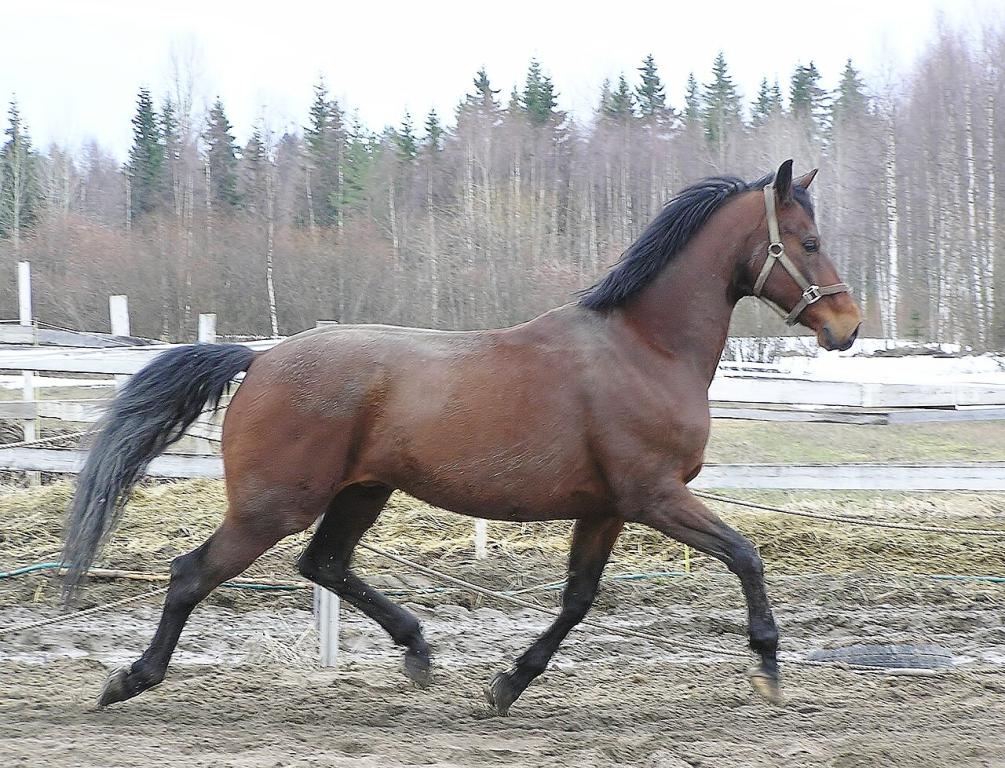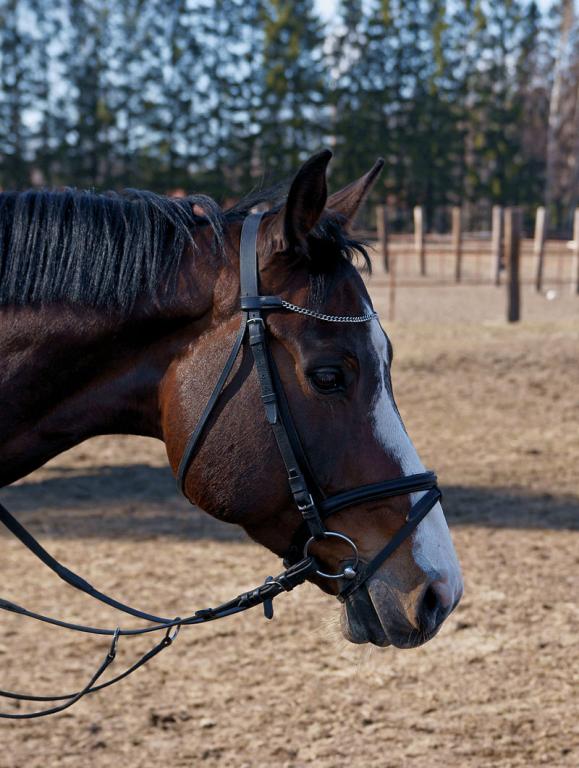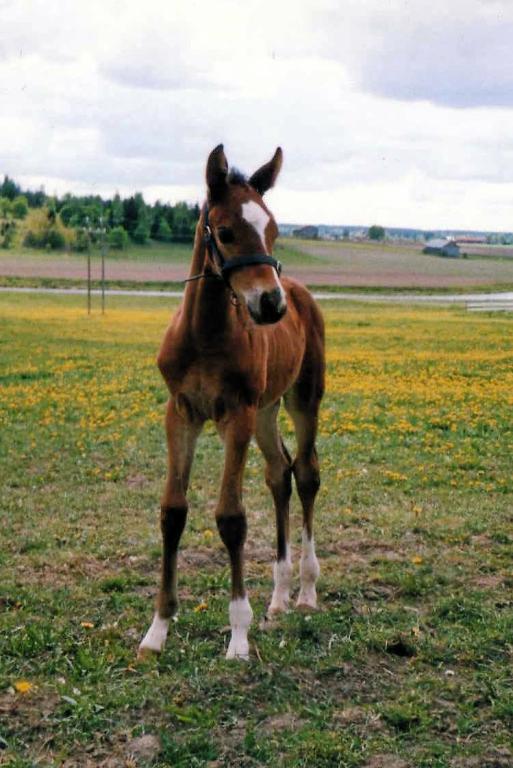
Continent: Europe
Country: Finland
Weight: 500 – 650 kg
Height: 158 – 172 cm


The Finnish Warmblood (Suomenpuoliverinen or FWB) originates from Finland, where its selective breeding began in the 1920s.
It was developed through crosses between European warmblood breeds (such as the Hanoverian, Trakehner, or Selle Français) and Thoroughbreds, with the goal of producing a horse suited both for military service and sport competition.
The development of the breed focused around national equestrian centers, primarily under the supervision of Suomen Hippos ry, the official Finnish organization in charge of equine breeding.
Breeding of the Finnish Warmblood (FWB) is primarily concentrated in Finland, where it is the national sport horse breed. Although found across the country, the most active breeding centers are located in the southern and southwestern regions:
– Around Helsinki and Uusimaa, which hosts many training and breeding facilities
– The Turku and Varsinais-Suomi region, historically linked to equine sports and horse farming
– The Tampere and Pirkanmaa area, known for its modern infrastructure
– Rural areas in Central Finland, such as Keski-Suomi, with specialized breeders
Approved stallions are used throughout the country, often via artificial insemination or breeding stations. National coordination by Suomen Hippos ry ensures a controlled and balanced distribution of bloodlines, promoting genetic consistency across the breed.
The Finnish Warmblood (FWB) is a cornerstone of sport horse breeding in Finland, developed to meet international standards for the modern sport horse.
It is the result of strict selection, coordinated by Suomen Hippos ry, which oversees the quality of bloodlines, sport performance, and genetic health.
The studbook allows the registration of horses born in Finland whose parentage includes recognized European breeds, provided the breeding stock is approved according to strict criteria. This controlled openness allows the FWB to benefit from a diverse genetic pool (including Hanoverian, Trakehner, Selle Français, Holsteiner, etc.) while maintaining morphological and functional consistency.
Thanks to its excellent movement, versatility, and balanced temperament, the FWB has become a valuable asset for sport breeding, especially in dressage and show jumping. It also plays a key role in promoting Finland’s national breeding program on the international stage.
Military Roots and Early Selection (1920s) :
The history of the Finnish Warmblood (FWB) begins in the early 20th century, as Finland sought to modernize its cavalry. In 1926, a national breeding program was launched to develop a versatile saddle horse, suitable for both military and civilian needs.
Local mares were crossed with European warmblood stallions (Trakehner, Hanoverian, Oldenburg) and Thoroughbreds, aiming to create a horse that was energetic, intelligent, and well-built.
Transition to a Sport Horse (1980s) :
As the Finnish cavalry was phased out in the 1980s, the FWB underwent a transformation. It became a horse dedicated exclusively to sport, with a focus on dressage, show jumping, and eventing. This shift led to a redefinition of studbook standards, now centered on performance, movement, and temperament.
Development Programs and Recognition :
To structure the breeding system and promote young horses, Finland introduced programs such as the Breeder’s Prize: a national competition open to FWB foals from birth, with specific events at 6 years old in dressage and jumping. This incentive-based system encourages early selection and supports breeders in their quest for quality and results.
Towards International Recognition :
Today, the FWB is a respected sport horse breed in Europe. Thanks to responsible management by Suomen Hippos ry, thoughtful genetic crosses, and a performance-driven selection, the Finnish Warmblood is steadily gaining visibility in international competitions, reflecting Finland’s expertise in equine breeding.
The Finnish Warmblood (FWB) is known for its balanced temperament, highly valued in both competitive and leisure contexts. Bred to be a reliable and high-performing sport horse, it combines key mental traits:
– Willing and hardworking: learns easily, enjoys working, and shows steady progress
– Energetic but manageable: expressive gaits without excess nervousness; pleasant to ride
– Brave and honest: approaches obstacles with determination without being reckless or fearful
– Respectful and social: adapts well to groundwork, group settings, and stays close to humans
– Mentally versatile: its stable disposition suits riding schools, competitions, and even trail riding
“Balanced, willing, and athletic, the FWB embodies the elegance of Nordic sport horses.”
The Finnish Warmblood (FWB) continues to develop with the goal of strengthening its presence on the international equestrian scene, particularly in Olympic disciplines like dressage, show jumping, and eventing.
Thanks to rigorous selection, controlled genetic input from top European lines, and professional oversight by Suomen Hippos ry, the breed is evolving toward a modern, competitive, and well-balanced sport horse.
Key objectives for the future include:
– Improving athletic performance while preserving the horse’s reliability and versatility
– Boosting international visibility of the FWB through competitions and promotion of Finnish bloodlines
– Supporting young breeders through funding and programs like the Breeder’s Prize, which encourages quality from birth
– Maintaining controlled genetic diversity, avoiding inbreeding while enhancing the breed with top European crosses
The FWB enjoys a reputation for reliability, good manners, and balanced performance, positioning it as a growing player in the European sport horse market and in professional stables.
The Finnish Warmblood (FWB) is generally considered to be a healthy and resilient breed, thanks to selective breeding focused on performance, longevity, and functional conformation. The Finnish studbook enforces strict veterinary criteria for approved breeding horses, including clinical exams and joint radiographs.
However, like many European sport horses, some health predispositions should be monitored:
– Joint issues (such as osteoarthritis or OCD) due to intense sport activity
– Tendinitis or ligament injuries from high-level training
– Occasional sensitivity to stress or digestive issues (e.g., gastric ulcers), particularly in competitive settings
Finnish breeders and riders prioritize rational management (gradual development, proper shoeing, balanced diet) to prevent such risks. The FWB benefits from supervised veterinary care under Suomen Hippos, ensuring a high overall health standard within the breed.
Born on 05/10/2003
Representing the Finnish national show jumping team, Jojo AZ stood out alongside rider Anna-Julia Kontio in numerous international competitions, including FEI World Cup™ events and CSI5 Grand Prix*.